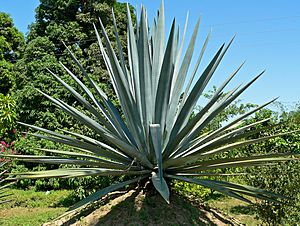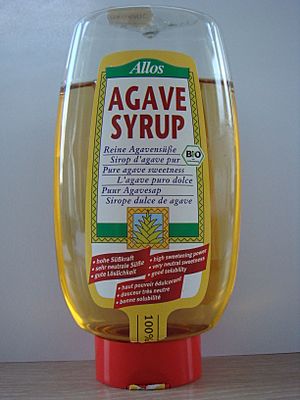Agave nectar facts for kids
Agave syrup is a sweet liquid used as a sweetener. Many people call it agave nectar, but that's not quite right. It comes from several types of agave plants, like the blue agave (Agave tequilana) and Agave salmiana. Blue agave syrup has a lot of fructose, which is a type of sugar that makes it sweet.
Most agave syrup comes from Mexico and South Africa.
How Agave Syrup is Made
To make agave syrup from plants like Agave americana and A. tequilana, farmers cut off the leaves after the plant has grown for 7 to 14 years. The sweet juice is then taken from the center of the agave plant, which is called the piña.
This juice is cleaned and then heated. Heating helps to break down the complex parts of the juice into simpler sugars. After this, the cleaned juice is cooked down until it becomes a thick liquid, a bit thinner than honey. Its color can be light or dark brown, depending on how much it has been processed.
Another type of agave, Agave salmiana, is processed differently. As this plant grows, it starts to grow a tall stalk called a quiote. Farmers cut off this stalk before it grows fully. This creates a hole in the middle of the plant that fills with a sweet liquid called aguamiel.
This aguamiel liquid is collected every day. Then, it is heated to break down its complex parts into different sugars like fructose, glucose, and sucrose.
Using Agave Syrup in Cooking
Blue agave syrup is very sweet, about 1.4 to 1.6 times sweeter than regular sugar. You can use it instead of sugar or honey in many recipes. Sometimes, it's added to breakfast cereal to help stick the ingredients together.
Agave syrups come in different types: light, amber, dark, and raw.
- Light agave syrup has a very mild, almost plain taste. It's good for foods and drinks that have a delicate flavor.
- Amber agave syrup has a medium caramel flavor. It works well in dishes and drinks that have stronger tastes.
- Dark agave syrup has a strong caramel taste. It gives a special flavor to certain foods, like some desserts, or even poultry, meat, and seafood dishes.
Both amber and dark agave syrups are often poured directly from the bottle onto pancakes, waffles, and French toast. The dark version is not filtered as much, so it has more of the plant's natural minerals.
If someone has fructose malabsorption, which means their body has trouble digesting fructose, they should not use blue agave syrup.
Images for kids
See also
 In Spanish: Aguamiel para niños
In Spanish: Aguamiel para niños





